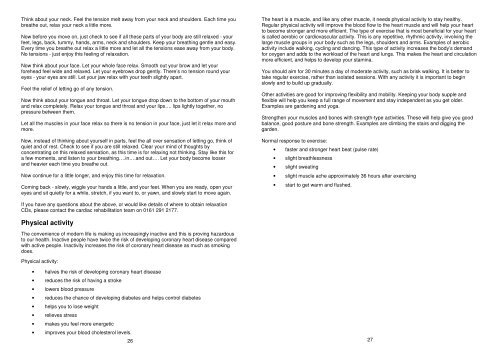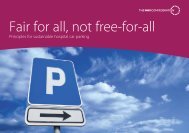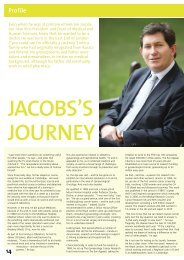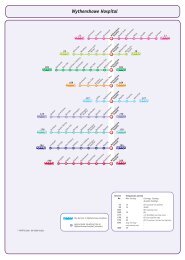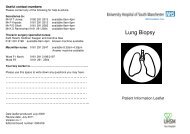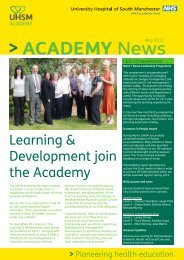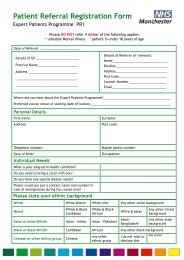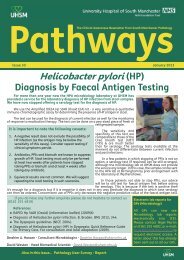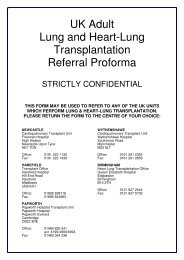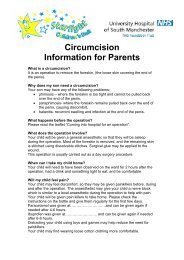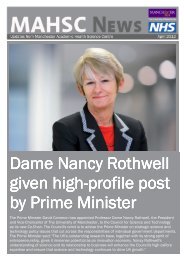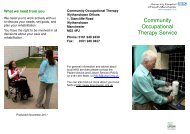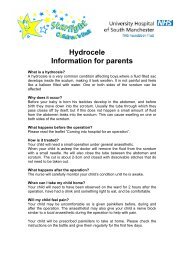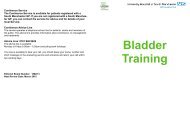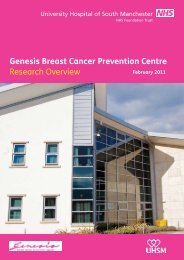A New Beginning 2012-7 - UHSM
A New Beginning 2012-7 - UHSM
A New Beginning 2012-7 - UHSM
Create successful ePaper yourself
Turn your PDF publications into a flip-book with our unique Google optimized e-Paper software.
Think about your neck. Feel the tension melt away from your neck and shoulders. Each time you<br />
breathe out, relax your neck a little more.<br />
Now before you move on, just check to see if all these parts of your body are still relaxed - your<br />
feet, legs, back, tummy, hands, arms, neck and shoulders. Keep your breathing gentle and easy.<br />
Every time you breathe out relax a little more and let all the tensions ease away from your body.<br />
No tensions - just enjoy this feeling of relaxation.<br />
Now think about your face. Let your whole face relax. Smooth out your brow and let your<br />
forehead feel wide and relaxed. Let your eyebrows drop gently. There’s no tension round your<br />
eyes - your eyes are still. Let your jaw relax with your teeth slightly apart.<br />
Feel the relief of letting go of any tension.<br />
Now think about your tongue and throat. Let your tongue drop down to the bottom of your mouth<br />
and relax completely. Relax your tongue and throat and your lips…. lips lightly together, no<br />
pressure between them.<br />
Let all the muscles in your face relax so there is no tension in your face, just let it relax more and<br />
more.<br />
Now, instead of thinking about yourself in parts, feel the all over sensation of letting go, think of<br />
quiet and of rest. Check to see if you are still relaxed. Clear your mind of thoughts by<br />
concentrating on this relaxed sensation, as this time is for relaxing not thinking. Stay like this for<br />
a few moments, and listen to your breathing….in….and out…. Let your body become looser<br />
and heavier each time you breathe out.<br />
Now continue for a little longer, and enjoy this time for relaxation.<br />
Coming back - slowly, wiggle your hands a little, and your feet. When you are ready, open your<br />
eyes and sit quietly for a while, stretch, if you want to, or yawn, and slowly start to move again.<br />
The heart is a muscle, and like any other muscle, it needs physical activity to stay healthy.<br />
Regular physical activity will improve the blood flow to the heart muscle and will help your heart<br />
to become stronger and more efficient. The type of exercise that is most beneficial for your heart<br />
is called aerobic or cardiovascular activity. This is any repetitive, rhythmic activity, involving the<br />
large muscle groups in your body such as the legs, shoulders and arms. Examples of aerobic<br />
activity include walking, cycling and dancing. This type of activity increases the body’s demand<br />
for oxygen and adds to the workload of the heart and lungs. This makes the heart and circulation<br />
more efficient, and helps to develop your stamina.<br />
You should aim for 30 minutes a day of moderate activity, such as brisk walking. It is better to<br />
take regular exercise, rather than isolated sessions. With any activity it is important to begin<br />
slowly and to build up gradually.<br />
Other activities are good for improving flexibility and mobility. Keeping your body supple and<br />
flexible will help you keep a full range of movement and stay independent as you get older.<br />
Examples are gardening and yoga.<br />
Strengthen your muscles and bones with strength-type activities. These will help give you good<br />
balance, good posture and bone strength. Examples are climbing the stairs and digging the<br />
garden.<br />
Normal response to exercise:<br />
• faster and stronger heart beat (pulse rate)<br />
• slight breathlessness<br />
• slight sweating<br />
• slight muscle ache approximately 36 hours after exercising<br />
• start to get warm and flushed.<br />
If you have any questions about the above, or would like details of where to obtain relaxation<br />
CDs, please contact the cardiac rehabilitation team on 0161 291 2177.<br />
Physical activity<br />
The convenience of modern life is making us increasingly inactive and this is proving hazardous<br />
to our health. Inactive people have twice the risk of developing coronary heart disease compared<br />
with active people. Inactivity increases the risk of coronary heart disease as much as smoking<br />
does.<br />
Physical activity:<br />
• halves the risk of developing coronary heart disease<br />
• reduces the risk of having a stroke<br />
• lowers blood pressure<br />
• reduces the chance of developing diabetes and helps control diabetes<br />
• helps you to lose weight<br />
• relieves stress<br />
• makes you feel more energetic<br />
• improves your blood cholesterol levels.<br />
26<br />
27


